Joyce T. Strand's Blog, page 11
August 23, 2015
WHAT THE EXPERTS SAY: Traci L. Slatton, Author
 Traci L. Slatton, Author
Traci L. Slatton, AuthorBLOOD SKY
Book 4 After Life SeriesInternational best-selling author Traci L. Slatton has just released BLOOD SKY, the 4thbook in her dystopian After Series that combines the apocalyptic with a poker game played in the American West to save the world. And there’s romance. She claims her characters led her there! Reviewers of her previous books praise her characters as “Believable, energetic, interesting characters who make very human choices facing inhumane foes and unbelievable circumstances.” Indeed, Slatton informs us that “facing our choices is part of maturation.”
Slatton, who lives in New York with her artist husband, spends most of her time writing. She is also growing her independent press, Parvati Press. She provided a previous interview for this blog when she released BROKEN, a paranormal historical fantasy.
Q: You have merged several genres into your new novel, BLOOD SKY, including, Dystopian/apocalyptic/American Western/Romance. How did you conceive of the story? Did you start with the concept of the world coming to an end and then look for intriguing ways to keep that from happening?
Traci L. Slatton: Joyce, good question and good eye, I did merge those genres. The whole series started with a scene that flashed into my mind a few years ago. It was a man and a woman, very much in love, walking away from each other. Behind them stretched a desolate world. From that initial scene came the whole edifice of the series…. I’m not sure I intended to merge the different genres, it just happened as the story unfolded and I stayed true to it.
Q: What inspired you to use a poker game as a means to win or lose all? Do you play poker? Did you have to research the game?
Traci L. Slatton: I grew up playing poker at the kitchen table with my mother, grandmother, sister, and various assorted friends and beaux. Poker was a time for us to connect and also a time for storytelling. My mother and grandmother were great raconteurs, and they usually had me in stitches over their tales.
Yes, I did have to do some research. My husband Sabin isn’t much for card games so I haven’t played in a while. I didn’t want to rely solely on my memory. Also, I played out the hands I wrote about.
Q: Reviewers of your previous books tout your characters. How do you make them engaging – especially in a dystopian world? Why do readers care what happens to them?
Traci L. Slatton: First, thank you for compliment! Second, for creating characters, I use two different methods. One is a character X system. This is a variation on something learned in David Freeman’s Beyond Structure screenwriting class.
A fully dimensional character needs 3-4 character traits to flesh him or her out. Fewer than that, the character feels flat; more than that, and it’s hard to get a handle on who the character is. So I draw out an X on a clean sheet of paper and I label each of the end-points with a character trait. I try to make sure that at least one of the traits isn’t too noble—I think it’s hard to relate to a character who’s too perfect. For example, Arthur’s basic four traits are: Charismatic, Intellectually Brilliant, Athletic, and Jealous. There are nuances, of course. But I always have the character X on hand when I work. It helps me keep the character coherent.
There’s another technique that I also use. I studied astrology for a long time, and I draw out charts for my characters. Sometimes the charts are just partial horoscopes, but they speak to me in rich symbolic form. For example, Arthur has Sagittarius rising and a Leo sun, Venus in Virgo. Emma has Virgo rising—the classic healer—and moon in Leo. Her moon interlocks with Arthur’s sun, and Arthur’s Venus in Virgo shows his appreciation of her.
Luca Bastardo, the protagonist of my historical novel IMMORTAL, had a hell of a tight Pluto-Venus square.
Those astrological signatures communicate to me in rapid shorthand and help me with character development.
Q: What do fans of dystopian fiction expect to read in a dystopian novel?
Traci L. Slatton: They expect to enter a speculative world that intrigues them and enlarges their consciousness, that shows a possibility under certain conditions. They expect the protagonists to meet extreme challenge and hardship, thus revealing their intrinsic character.
Q: How helpful is setting (Old West?) to tell your story? Does it add to the suspense, romance, or character development?
Traci L. Slatton: Well, the Old West just crept itself in, unbidden. I work in two ways in writing a novel: 1, from an outline, and 2, from wild inspiration. I usually start a novel in a burst of oceanic creativity, from a scene or a character who emerged from my unconscious. But sometime during the first chapter I’ll write an outline to structure the story. There is craft involved, you know?
But I also allow and cultivate the oceanic, protean nature of creativity, which means that themes and motifs and characters crop up and I don’t know why but I allow them to emerge and then I pursue them. It’s a process of trust and discovery, and it’s part of the fun of writing a novel.
So that’s how Outpost City and the Old West came into my dystopian tale. I think it adds resonance and richness….
Q: I know that you write to entertain, but in previous books you’ve also had a message or two that you wanted to deliver. Is that true for BLOOD SKY? Did you have something you wanted readers to think about?
Traci L. Slatton: There are some ideas that matter to me. For one, we have greater abilities than the concrete senses that Newtonian science acknowledges, and I try to share that with readers. Also, BLOOD SKY turns around Emma’s choices. She has to come to understand that she is making a choice at every turn. I think facing our choices is part of maturation.
Q: Does humor help to tell your story or develop your characters?
Traci L. Slatton: There tends to be humor in my stories, and my characters tend to have humor. Some of my characters can be humorless if that’s who they are—I am true to my characters. Arthur’s a bit humorless, I find. But he’s so hot, does it matter?
Q: What’s next? Will you leave the dystopian world?
Traci L. Slatton: I write the After Series novels between stand alone works.
Having finished BLOOD SKY, I’m currently working on a novel called THE YEAR OF LOVING. It was entitled THE YEAR OF LOVING A YOUNGER MAN, but then the protagonist went and got herself involved in a love triangle with a younger man AND an older man, and her best friend has cancer, so I realized it was THE YEAR OF LOVING. I’m also researching the siege of Montsegur and the Cathars for a historical novel.
Q: What have you been doing since you last visited here almost a year ago? Anything fun?
Traci L. Slatton: Writing, writing, writing! And growing my independent press, Parvati Press.
About Traci L. Slatton
Traci L. Slatton is the international bestselling author of historical, paranormal, and romantic novels, including IMMORTAL (BantamDell) and BROKEN; the award-winning dystopian After Series which includes FALLEN, COLD LIGHT, FAR SHORE, and BLOOD SKY; the bittersweet romantic comedy THE LOVE OF MY (OTHER) LIFE; and the vampire art history romp THE BOTTICELLI AFFAIR. She has also published the lyrical poetry collection DANCING IN THE TABERNACLE and THE ART OF LIFE, a photo-essay about figurative sculpture through the ages. Her book PIERCING TIME & SPACE explores the meeting ground of science and spirituality.
 About BLOOD SKY
About BLOOD SKY In a time of apocalyptic despair, love is put to the test… Deep in the badlands of Outpost City, in the Dark Horse saloon, a poker game is being played. The stakes are life and death—for the world. What can Emma afford to lose? Will she gamble on herself, or on Arthur? Will love find a way when the apocalypse closes in? A mystical odyssey, a haunting love…
Purchase Link
Amazon Kindle BLOOD SKY FALLEN COLD LIGHT FAR SHORE FALLEN, COLD LIGHT, FAR SHORE: The After Series Books 1-3
Author LinksWeb siteBlog@tracilslattonFacebookGoogleGoodreadsI-TunesYou-Tube
BLOOD SKY Trailer: https://youtu.be/moBlcXPG33o

Published on August 23, 2015 19:06
August 18, 2015
WHAT THE EXPERTS SAY: Sherel Ott, Author
 Sherel Ott, Author
Sherel Ott, AuthorADVENTURES OF PRINCESS JANAI AND
THE WARRIOR MAIDENS OF QUINU:
THE CITIES OF TONGA AND TONGIASherel Ott wrote ADVENTURES OF PRINCESS JANAI AND THE WARRIOR MAIDENS OF QUINU: THE CITIES OF TONGA AND TONGIA primarily to entertain middle grade girls. She also noticed that there were few books or animated movies with girls of color as leading characters. She chose fantasy as the genre to best tell her story because she likes being able to “step outside of your reality.”
When she’s not writing, Sherel is a Family Nurse Practitioner. She is also taking drawing lessons and cake decorating classes, loves reading , and enjoys crocheting. She is currently working on the next Princess Janai story.
Don't miss the excerpt and the opportunity for a giveaway at the end of the interview.
Q: Why did you choose Fantasy/adventure as the genre to tell your story, ADVENTURES OF PRINCESS JANAI AND THE WARRIOR MAIDENS OF QUINU: THE CITIES OF TONGA AND TONGIA?
Sherel Ott: I chose fantasy/adventure as a genre because I like how you can step outside of your reality into a whole other world. Being able to immerse yourself in it and forget about your present reality and problems for a while.
Q: What or who inspired your main character, Princess Janai? Did you base her on a real person?
Sherel Ott: My main character was named after my niece Janai. It was originally written with her in mind, but once I started writing…the character took on a life of her own, she wanted to be different.
Q: How do you write to reach your target age group, which I understand to be middle grade girls? Do you use different dialogue techniques, backstory that will appeal to this age group, or characters of their age? Other?
Sherel Ott: I’m a big kid at heart, and I remember some of the things I went through as a tween. I listen to some of the stories that children talk about today and the issues that they face. I then put myself in those shoes and try to see things from their point of view. I do try to give a little back story so that people will/can understand where a certain character is coming from. Having the characters in that age group also makes it more relatable for the readers, they are more apt to identify with someone of their own age.
Q: Did you write ADVENTURES OF PRINCESS JANAI to entertain only or did you include themes to help educate or guide?
Sherel Ott: In the beginning, it was mostly to entertain. That is mostly what the first book is, but the follow up books will be both entertaining as well have an education/lesson imbedded in there.
Q: Do you use setting to help tell your story and/or advance your theme? If so, how?
Sherel Ott: The setting is more of a backdrop for the stories. They do help advance the story along in places but they are not the main focus. I want to provide an all around experience for the reader as much as possible. Give enough details but allow their own minds to fill it in.
Q: Why are your characters “relatable”? Does humor help you develop your characters? Why will your readers care about them?
Sherel Ott: I try to make them as human as possible, with feelings and emotions that we all go through. I think giving them those emotions and feelings helps the readers to like or dislike them making them relatable to either themselves or someone they know. Then, they will either cheer for them or hope they get their come-uppance for their bad deeds. Not always will they though…that would end the story too soon.
Q: Is the concept of heroes vs villains important to tell your story?
Sherel Ott: Actually, no. I try to make it more the situation that creates the villain or bad person. In some instances who you think is bad might actually be a good person, just misguided in what they do and believe and vice versa. The main antagonist in the series will be Serlina, but as the stories progress, you will find a more human side to her. It might not justify what she is doing but you will understand more from her point of view.
Q: What do you believe are the most important elements of a story to reach the middle age group of readers?
Sherel Ott: I believe that if you have something exciting going on that they would really like to do themselves and add a little danger, a lot of colorful characters and believable situations (whether it is make-believe or real) it will garner their attention. If the story and details of the surroundings are enticing, you just might have their attention. The middle age group vary in their level of imagination and maturity. You want to try to appeal to all levels without alienating anyone.
Q: What’s next?
Sherel Ott: In the next story, we find Princess Janai at the end of the mandatory training sessions and conflicts arising within her own group. We find one of the supporting characters having to deal with her low self-esteem and self-confidence, and as she comes to terms with her issues of her weight and size; she finds a friend in someone else who is going through the same exact problem, but a little opposite.
Q: Tell us about Sherel Ott. What do you like to do when you’re not writing?
Sherel Ott: When I’m not writing, I’m a Family Nurse Practitioner. I love helping take care of people and I chose this particular path because I saw that a lot of the providers were becoming more and more specialized. Being a family practice provider was becoming a dying art. We have Pediatrician…Internalist…Cardiologist…Nephrologist…Gastroenterologist, but not a lot of general practitioners; people who can take care of you from as I was told… from lust to dust. I’m also taking drawing lessons and cake decorating classes on and off. Reading has always been a favorite pass time of mine as well as crocheting.
About Sherel Ott
An eclectic collector of animation movies, Sherel Ott is a writer of fantasy and romance stories. One day while watching an animated movie, she noticed that there weren’t a lot of movies or books with girls of color in leading roles…as heroines, adventurers or with strong moral characters and wondered… Where were the influential leaders, doctors, lawyers or royalty of color? Why weren’t there any strong black female characters where a girl of color could be proud of her skin color and the type of person representing and say … “I want to be like her!” Wanting something more for her own nieces to look up to and strive to emulate, other than what girls of color were currently being portrayed as or should settle for is how her book initially took form. She wanted to show that there are black princesses, warriors, adventurers of all walks of life. That she should be and can be recognized for what she does and who her true self is, not be prejudged by what color her skin was.
As a fan of all fantasy, magical, mystical, celestial and other worldly creatures, Sherel began reading sci-fi/fantasy stories at a young age.
"I have always been a sci-fi and fantasy type of person. I always felt as a child that I belonged in those types of worlds rather than here. Reading them had always been my way of escaping from my shyness as a child."-Sherel Ott. She had started collecting fairies of all types and now has a mini collection of collectible faery ornament to decorate her Christmas tree every year.
Sherel creates her stories first by writing them out and then typing them on the computer. She feels she gets her inspiration greatest when she writes and from nature itself. She strives to present her stories in a way that anyone can relate and identify with no matter how old or young...with a little fun, a little action/adventure, yet with a hidden message. Writing since the age of 14, her first published book -ADVENTURES OF PRINCESS JANAI AND THE WARRIOR MAIDENS OF QUINU: THE CITIESOF TONGA AND TONGIA - brings a story of strong African American females. It's an adventure series particularly geared towards girls, although boys will also find it an enjoyable read.
When Sherel is not writing, she is working as a full-time Family Nurse Practitioner and has been so for the past 17 years. She presently resides in Felton, DE. About ADVENTURES OF PRINCESS JANAI AND THE WARRIOR MAIDENS OF QUINU: THE CITIES OF TONGA AND TONGIA
 All Janai wants is to be just like everyone else. Being the Princess and having to try out for the Warrior Maidens is just part of her problems. She has the present Warrior leader unhappy with the fact that she is trying out, because that means her time is almost up and she enjoys her “status” too much to give it up without a fight. Not to mention someone just froze two of her guards into living statues with the fabled Mist Flowers of Tonga. Now she and a small group of warriors must travel to a forbidden city and obtain the antidote before the two guards are lost forever…all in 24 hours. Is she capable? Will she make it in time?
All Janai wants is to be just like everyone else. Being the Princess and having to try out for the Warrior Maidens is just part of her problems. She has the present Warrior leader unhappy with the fact that she is trying out, because that means her time is almost up and she enjoys her “status” too much to give it up without a fight. Not to mention someone just froze two of her guards into living statues with the fabled Mist Flowers of Tonga. Now she and a small group of warriors must travel to a forbidden city and obtain the antidote before the two guards are lost forever…all in 24 hours. Is she capable? Will she make it in time?Excerpt
Once every year in the village of Quinu, the maidens of the village from age 16 to 18 are allowed to try out for a position as a Warrior Maiden and protector of the Quinu people. The competition matches the maidens go through are very strenuous and demanding. These matches last for two weeks each spring and very few maidens will make rank on their first attempt. Those that do, are extremely talented and athletic.
This spring year happened to be very different and special. The whole village turned out to watch the competition, for a certain 12-year-old girl was to be involved in the competitions.
Now this was no ordinary 12 year old, for even though she was young, she already showed that she was going to be a beautiful woman. She has skin as smooth as a pebble in a running stream and the color of rich mahogany. She has large almond shaped eyes the color of a new leaf in spring, long coltish legs and a torso that was just hinting at what she will look like in a few years.
Her hair and its ornaments distinguished her status. The top of her head has three braids that arched out and upwards; then joined at the center of her head to form three arches (one in the front and one on each side of her head just above her ears to form a crown of sorts). At the back of her head, her hair is pulled into a ponytail and hangs down to the center of her back in one long corkscrew braid.
And on her forehead just below the center arch, a circular ornament made of gold with an amethyst surrounded by four diamonds hangs. The ornament is attached to a gold thread, which is woven in and out of her hair. This ornament is worn mostly on ceremonial occasions. Normally, she wears a diamond shaped amethyst stone also attached to a gold wire/thread which is weaved in and out of her hair.
This hairstyle and decorations distinguishes the Princesses of Quinu.
Now Princess Janai has made it through the first week of tryouts and out maneuvered all her opponents. The second week proved to be more demanding and competitive as the participants were narrowed down to only twenty entrants.
Serlina usually did not participate in these competitions, but Princess Janai was making fools out of her Warriors. She has not lost one match in the last week and a half since competition started. Serlina decided that she would be the Princess’s opponent for the last three of her matches, just to see if she was really that good or if the warriors were just afraid to harm her. Her Warrior Maidens were afraid of no one, but were aware that their main objectives were to see that the Royal Family came to no harm.
By the second to last day of competition, everyone forgot about the other entrants. Everyone was interested only in Princess Janai and Serlina’s hand-to-hand combats. The maidens who made it to the final combat were already considered to be part of the Warrior Maidens. The announcement at the Ceremony of Feast was only a formality. The competition between the Princess and the leader of the Warrior Maidensthough, was not only highly unusual, but an event not to be missed.
“That impertinent brat! How DARE she humiliate me in front of all those people,” roared Serlina. “A twelve year old little nobody. She will pay for this.”
“But Mistress Serlina, she is the Princess,” Serlina’s second-in-command, Zara said.
Purchase Link Amazon
Author Links:Webpage Facebook Twitter: @SherelOttAuthor
Giveaway:1st Prize: $50 Amazon.com gift certificate and signed copy of About Adventures of Princess Janai and the Warrior Maidens of Quinu: The Cities of Tonga and Tongia2nd Prize: $25 Amazon.com gift certificate and signed copy of About Adventures of Princess Janai and the Warrior Maidens of Quinu: The Cities of Tonga and Tongia3rd Prize: $10 Amazon.com gift certificate and signed copy of About Adventures of Princess Janai and the Warrior Maidens of Quinu: The Cities of Tonga and Tongia
Giveaway on Facebook at http://gvwy.io/om690v2

Published on August 18, 2015 18:06
August 10, 2015
WHAT THE EXPERTS SAY: Christine Amsden, SciFi/Fantasy Author
 Christine Amsden, SciFi/Fantasy Author
Christine Amsden, SciFi/Fantasy AuthorMADISON'S SONGAward-winning SciFi/fantasy author Christine Amsden brings us her newest novel, MADISON’S SONG, described as an “adventurous paranormal romance.” Reviewers tout it as a “fast-pace, highly entertaining read with fully sympathetic and compelling characters.” Amsden, who has written and published more than a dozen novels, including the Cassie Scot, paranormal detective series, says that above all she writes stories “about people” and claims that “Great characters come from the heart.”
Amsden, who likes to spin off characters to tell new stories, has many ideas for her next novel, but has not yet decided what it should be. A free-lance editor, she currently lives in Kansas City with her husband and two children. When she’s not writing, she likes to read and watch TV – especially science fiction shows.
Q: Your newest book, MADISON’S SONG, crosses several genres, including romance and paranormal. How/why did werewolves appeal to you as a way to tell a story about romance? Or do you use romance to tell a story about werewolves?
Christine Amsden: I definitely used werewolves to tell a story about romance! :)
I'm a character girl. First and foremost, setting aside all genres that I can and have brushed against, I tell stories about people. Fantasy is fun and magical; I love it! But also, it puts ordinary people in extraordinary situations, giving us a chance to see who we are and who we can be when put to the test. And that's what I did to Madison – put her to the test. I forced her to face her greatest fear in order to save a brother she loves. Along the way, she falls in love with Scott, a werewolf who doesn't believe he's worthy of a woman like Madison.
Q: Your reviewers praise MADISON’S SONG and say it is a “fast-paced, highly entertaining read with fully sympathetic and compelling characters.” In a paranormal romance how do you make your characters sympathetic and compelling? Does the world-building enhance or detract from your characters?
Christine Amsden:Good world-building enhances the characters. It puts them to the test. It shows us what they're made of.
Great characters come from the heart. I put a piece of myself into each and every character I create. And Madison … well, when I first created her as a minor character in another series, she wasn't supposed to have her own book! So I made her a little too much like me. This became a challenge when she took the spotlight, along with all the little insecurities I have about myself – weight, shyness, men … I even chew my nails and my bottom lip the way she does!
But when I put Madison to the test, I also put myself to the test. What would I do if someone I loved were in danger? I hope I would become the lioness Madison becomes!
At any rate, the magical world Madison tackles head-on is in every way a test of character and a test of self.
As a counter-example: Bad world-building usually involves some magic gift or talent that makes life easier for the protagonist. I see this too often in paranormal mystery, in which a psychic uses a gift to solve a crime that couldn't otherwise have been solved by normal means. I've never enjoyed this type of story because it's too easy. Instead of the magic being a source of conflict, it's a deus ex machina – a gift from heaven that conveniently solves the problem.
Q: Did you do any research of werewolf lore to tell your story? Or did you create the backstory from your imagination?
Christine Amsden:Strangely enough, I did a research project on werewolves when I was in the sixth grade! I've read lots of shapeshifter books and stories since then, so that by the time I wrote this book there wasn't much left to do except decide which of the many versions of a werewolf to embrace. For me it went back to that sixth grade research project – I chose the man who becomes a monster at the full moon.
Q: Reviewers almost without exception appreciated the pace of MADISON’S SONG: “action and thrills abound” “non-stop action” “intensely riveting” and my favorite “What I didn’t like about this book, was that it ended.” How did you develop such a page-turner? How important is suspense to telling your story?
Christine Amsden: “What I didn’t like about this book, was that it ended.”
:) :) :)
Yeah, I loved that one too!
Suspense is the glue that holds my stories together. When I develop a story, character is my most important consideration and it's where I start. World building comes next – a home for my characters. After that I look for something to propel the plot forward, something that will help me explore the characters and the world I put them in. That's suspense.
Before I can excite the reader, I have to excite myself. To get them to turn pages, I first need to get myself to write them! I have a short attention span and am easily bored. As a young reader, I used to skim past paragraphs that were too long, eager to get to the good parts! So as an author, I try to only write the good parts.
Q: What makes readers accept werewolves as part of a credible world? How do you make them believable? What leads to credibility in a paranormal story?
Christine Amsden: I own it. This is sort of my mantra – before I can sell it, I first have to believe it myself. I have to own it. When I write about magic, I make no apologies and take no prisoners.
Q: How helpful is humor to telling your story?
Christine Amsden: Comic relief is critical, especially in a book that goes dark like Madison's Song did. And in terms of romance I think that if there's too much darkness, it's hard for a reader to believe in the happily ever after. Love can't just be built on shared tragedy; it needs shared humor as well.
Q: Did you write MADISON’S SONG strictly to entertain or did you also have a message you wanted to deliver?
Christine Amsden:
Themes:
“Love yourself.”
“You never know how strong you are until you have no other choice.”
“Don't let fear rule your life.”
Or just have fun!
Q: Does the concept of hero vs villain apply to MADISON’S SONG? What are the characteristics of an effective villain? Do you need a villain to have a hero?
Christine Amsden: There are several villains in Madison's song – one major villain who has been a recurring character (but who stays behind the scenes in this book) and a couple of minor villains. Villains aren't absolutely necessary (a hero can overcome nature or fate or himself), but they're useful.
I like villains who aren't pure evil. I may be naive, but I don't believe that people set out to be evil, or that anyone, no matter how bad, believes himself to be evil. He has his reasons for what he does (no matter how poorly justified).
And now I feel like I'm getting ahead of myself, because all of this is actually a huge theme in my next book, Kaitlin's Tale, in which I take a villain from a previous book and turn him into a hero. :)
Q: What’s next? Will you spin off another character or write more about Madison?
Christine Amsden: Madison's story is over, though she may appear in future books. Once this situation is resolved, she would really prefer to teach music to children, and maybe have some of her own.
Kaitlin's Tale is next. Kaitlin is another friend of Cassie and Madison who grew too big for her original role in the Cassie Scot series. That book is finished and under contract – it will probably be out next summer.
As for what's next …. I don't know! That's as honest as I can be. I've come up with several ideas but none are calling to me strongly enough at the moment. I have ideas for completely new stories in completely new worlds, and I have ideas for more Cassie Scot stories (one involving Cassie herself, and several involving her brothers and sisters).
A few days ago I considered doing a reader poll asking what fans think I should write next. :)
Something will call to me soon, I'm sure. I only hope fans will be as enthusiastic as they have been about my Cassie Scot books.
Q: Tell us something about Christine Amsden. What do you like to do when you’re not writing?
Christine Amsden: I'm a freelance editor and a mom. I enjoy reading, especially fantasy and romance, and I enjoy watching TV, especially science fiction. I'm currently rewatching Sense8 in the background, my new favorite show.
About Christine Amsden
Christine Amsden has been writing science fiction and fantasy for as long as she can remember. She loves to write and it is her dream that others will be inspired by this love and by her stories. Speculative fiction is fun, magical, and imaginative but great speculative fiction is about real people defining themselves through extraordinary situations. Christine writes primarily about people and it is in this way that she strives to make science fiction and fantasy meaningful for everyone.
Christine currently lives in the Kansas City area with her husband, Austin, who has been her biggest fan and the key to her success. They have two beautiful children.
 About MADISON’S SONG
About MADISON’S SONGHer voice is enchanting; his soul is black…
Madison Carter has been terrified of Scott Lee since the night he saved her from an evil sorcerer – then melted into a man-eating monster before her eyes. The werewolf is a slave to the moon, but Madison’s nightmares are not.
Despite her fears, when Madison’s brother, Clinton, is bitten by a werewolf, she knows there is only one man who can help. A man who frightens her all the more because even in her nightmares, he also thrills her.
Together for the first time since that terrible night, Scott and Madison drive to Clinton’s home only to discover that he’s vanished. Frantic now, Madison must overcome her fears and uncover hidden strengths if she hopes to save him. And she’s not the only one fighting inner demons. Scott’s are literal, and they have him convinced that he will never deserve the woman he loves.
*Stand-alone companion to the Cassie Scot series
Links
Purchase
Amazon
B & N
Author
Christine's Website / Goodreads / Twitter / Google +
Follow the entire TOUR HERE
Brought to you by Worldwind Virtual Book Tours
Published on August 10, 2015 19:52
August 6, 2015
WHAT THE EXPERTS SAY: Dorothy Distefano, Editor for Tom Reitze about Tom Reitze
 Dorothy Distefano, Editor
Dorothy Distefano, EditorTom Reitze's PEJITO
DATE WITH A CHAIR
BERNICE'S BONES
DEKLYNTom Reitze has pulled yet another “fast one” on us – he sent his editor to let us know that he’s released PEJITO, the third story in his "Stories of a Different Nature." But we are privileged to have her, because as an editor Dorothy Distefano gives us insight into how he tells his stories. As you might imagine from my previous two interviews of Tom (Interview 1 and Interview 2), he doesn’t do editing in a manner similar to most, and Distefano, an experienced and hard-working editor--and so much more--, manages to overcome his “quirkiness,” for which we learn she is well suited!
PEJITO is a short story—again in the paranormal fiction genre—about a marionette with “an air of evil around it.” It joins the first two short stories, DATE WITH A CHAIR (1) “not a story to produce joy and happiness” and BERNICE’S BONES (2)—“If it doesn’t make you laugh, that’ll make me cry.”
And I’ve heard that Tom has written a novella with supernatural tendencies called DEKLYN, that is available for pre-order.
An Editor’s Story Or, How Tom Reitze’s Quirky Plots Become Quirkier By Dorothy Distefano, the one who gets them there
I feel very privileged to be Tom Reitze’s proofreader, editor, and pain in the neck. Just ask him. He will definitely agree with the pain part.
Every writer has a different process, and Tom’s differs greatly from my other clients. He doesn’t want to send me a manuscript and receive it back with suggestions and changes. We tried this. He was quite unhappy and autocorrect added words like hatchet and decapitation into his emails. At least I hope it was autocorrect. Tom wants to know WHY something doesn’t work. He wants to understand the reasoning behind every suggestion or change. This is why we meet every week and go through each manuscript line-by-line. I add comments where we agree things need to change, including my favorite, “This sucks.” He looks forward to those (not).
Along the way, as we meander down the path of each story, I call him out on plots that develop too quickly or too slowly, characters that change hastily, or things that just need clarification. His upcoming novella, DEKLYN , which is available for preorder, was a very short story until my brain revved up and I said, “I have an idea,” which makes all of my clients cringe, but ultimately ends up in some interesting ideas.
Tom’s plots are already quirky when we begin and probably more quirky when we finish. He has no interest in split infinitives or any other grammar conventions. If he likes the way it sounds, who am I to argue? I only insist on changes that clarify sentences and story structure. He has his style, he likes it, and I go with the flow… to an extent. There will be no omissions of the Oxford Comma. Ever.Stories of a Different Nature all contain supernatural phenomena, as does DEKLYN , but the next book series may be more of a tasting menu of stories. A smorgasbord, if you will. They will still be unconventional, but not all supernaturally based or revolving around paranormal happenings. There are some single holiday stories ready for Thanksgiving and Christmas, a new set of books that are as yet unnamed, and then we plan to tackle Tom’s greatest work, Simon. It is a novel he has worked on for several years and is bound to delight readers. In my mind, this means we will come around and bind them with duct tape and read it to them until they are delighted. But that’s just me.
I enjoy working with Tom because he allows me to make suggestions and feels comfortable either accepting or rejecting my ideas. Often, my suggestions require extra work on his part, but he does it, and he does it well. We are a good team.
Our cover designer, who happens to be my son, has done a great job of taking the disturbing nature of the current series and putting the covers together to complement each story. We will be giving away special edition wallpapers with the symbols for each novel in Stories of a Different Nature for everyone who retweets or shares our posts about the DEKLYN presale. Warning: this wallpaper is pretty spooky.
About Dorothy Distefano by Dorothy Distefano
I am the Writer on the Verge.
In addition to working with Tom Reitze, author of Stories of a Different Nature, I am (in no particular order) a wife and mother, freelance writer, team leader, reader, LOST fanatic in mourning, nerd, tech lover, and drumline costumer. I put words in the correct order with appropriate punctuation in a way that seems pleasing or at least agreeable. I love the Oxford comma, regardless of what AP style says.
My work history includes psychiatric nurse, teaching assistant, PTA Prez, volunteer, and family book club creator. To sum it up: I wasn’t afraid; I tried new things and if I didn’t know how, I learned; I spoke my mind; I helped; I loved; I did my best. I still do all of these things in whatever tiara I am wearing, whether editor, writer, or mother. My dream is to publish my own novel.
If this was an extended bio, I would tell you about teaching my cat to jump through a rolling hula hoop when I was 5.
About Tom Reitze by Tom Reitze
“I am a very opinionated individual and was sure I knew what was wrong with society and how to fix it. I planned to write a series of editorials and bind them into a book. Before I started, I realized no one in the world would give a damn about what this unknown writer had to say. I decided to expose my feelings in the form of fictional stories, something people would be more likely to read.
"My 22 lb. cat, Horus agrees. He is very opinionated as well. I am contradictory. I will present one idea at one time, and then write another story that presents the opposite concepts. I like to believe I am a person willing to listen to and consider both sides of an issue. Some of my writing is serious, some of it is supernatural in nature, and some of it is humorous (I hope).”
 About PEJITO (Stories of a Different Nature Book 3)
About PEJITO (Stories of a Different Nature Book 3)On a shelf, amidst the clutter of tchotchkes from mundane to fascinating hangs a marionette. It appears to be a relic of an earlier age with the face of clown. Why, of all of the tokens in the room does this one have an air of evil around it?
About DEKLYN
This "between the Stories of a Different Nature" novella started as just another story. DEKLYN demanded that there was more than those few words to his tale. An escape from a life of beatings; a journey in a desolate desert; unimaginable powers; and forces beyond all understanding await you. Deklyn would like you to read it. At one time, he could have made you read it, but now it is your choice.
Links for Tom Reitze

Amazon link for PEJITO - available now
Amazon link for DEKLYN - available for pre-order
Amazon link for BERNICE'S BONES
Amazon link for DATE WITH A CHAIRWeb page Twitter - https://twitter.com/tomwritez
Links for Dorothy Distefano
WebpageLinkedInwotv@wotverge.com
Published on August 06, 2015 19:14
August 3, 2015
WHAT THE EXPERTS SAY: Krystal Diane, Children’s Author
 Krystal Diane, Author
Krystal Diane, AuthorBABY BEAR BLUE'S NEW SISTER!Krystal Diane brings us her first children’s book, BABY BEAR BLUE’S NEW SISTER!, which she wrote to prepare her niece for her new baby brother. Reviewers enjoyed the “very cute story” and say the “precious theme of welcoming a new sibling in a darling rhyming dialogue is very appealing.” Although she uses bears as her characters, she says that she wrote it to be realistic with a clear message.
Diane plans to write more Baby Bear Blue books. This is her first published work but she has been writing since she was ten with a life-long dream of publishing books. She lives in Florida with her husband and baby son and is finishing her college degree in Marketing.
Q: What inspired you to write BABY BEAR BLUE’S NEW SISTER!? Have you experienced introducing a new baby to an older sibling?
Krystal Diane: I was inspired to write BABY BEAR BLUE’S NEW SISTER! by my niece. She was expecting a baby brother, and I thought it would be helpful to write a story that would prepare her on what was to come. I think it is always a sticky situation for the parents, and they are not sure how the little one will react to this new baby on the way. I just wanted to make it a little bit easier for them to explain to their children and know what they have to expect. The reason I wrote it from a boy’s point of view is because I have a son of my own, and wanted to make it personal for him when we have a new one on the way in the future.
Q: How do you engage 3-5 year olds? Does using a bear as the protagonist help?
Krystal Diane: I do hope the illustrations done by Da’an Yayha will be inspiration enough for them to want to read. Also, I found that bears are very popular among children for children’s stories that are #1 sellers, so I wanted to mirror that.
Q: I notice that you rhymed your story, and many of the reviewers enjoyed the rhyme. Does that make toddlers want to hear the story? Will most “readers” of this book listen to it being read to them? So would the rhyming make it more interesting to them as they hear the story?
Krystal Diane: Yes, I wrote it in rhyme form to attract the young readers’ attention a little bit better. When I read to my son, I much enjoy the rhyming stories a little bit better than anything else, especially for the 3-5 age range. I believe it makes it that much more interesting. Most of my target age group will be read to, and it will be the mothers who will purchase the story. I aimed it toward them, and hopefully they will want to read this to their children when expecting a new baby, boy or girl.
Q: How helpful are the illustrations for this age group? Did you write the story first and then the art followed?
Krystal Diane: For this age group, illustrations are an absolute must! I believe it keeps them engaged in what’s going on in the story, as well as help them envision what is happening. For this book, I wrote the story first, and then had it illustrated. Da’an Yayha really captured perfectly what I had in mind for this book, and I am very happy with what she did for my very first children’s book!
Q: One of your reviewers said that the book is entertaining but also has “a good moral” by showing “what older siblings should do for their younger ones.” Did you intend for your book to be a teaching one? Or were you just writing it to entertain?
Krystal Diane: I was certainly writing to entertain, but the most important thing to me was that it had a lesson involved as well. I have always believed that every story should have a moral to teach kids. They should not even realize they are learning, but enjoy what they are reading or listening to. This was definitely on my mind as I wrote the book.
Q: What do you believe are the most important elements of a children’s story?
Krystal Diane: For me, what I was aiming at to be important in the story is to show young children that when there is a new baby on the way, it can be exciting, even for them! I wanted to show them that they can be of great help to their parents when the new baby finally does arrive. They can be involved, and just because there is a new sister/brother for them, does not mean that they are less loved by their parents. I think this is the most common worry that kids have when they find out they will no longer be an only child.
Q: How relevant is believability to create credibility for this age group? Does it even matter?
Krystal Diane: I think that for this particular story, I wanted to keep it as believable as possible, considering the characters are bears. There is nothing wrong with exaggerating a little bit to make a moral point, but in my stories, I will keep them close to real life apart from the characters in each story.
Q: Is this your first book? Have you written other types of stories?
Krystal Diane: This is my first book I have published. I have been writing stories since I was ten years old, and have always loved to write. I am so excited to finally release my very first children’s book to Amazon Kindle, and there are many more to come!
Q: What’s next? Will you write more children’s stories? Others?
Krystal Diane: Yes, Definitely! I have more on the way, and actually plan to make this into a series. Baby Bear Blue will have many more adventures and lessons to come, so stay tuned!
Q: Tell us about Krystal Diane. What do you like to do when you’re not writing?
Krystal Diane: When I am not writing, I love to spend time with my baby boy and my husband. We live in Florida, so we are always at the beach. We love to be outdoors, and spend as much time together as we can while I am finishing up my Bachelor’s degree in Marketing. I also enjoy dancing and singing, and anything to do with Performing Arts. I have many different hats that I wear, and I love each and every one of them!
About Krystal Diane
Krystal Diane is the mother of a beautiful baby boy. She has always dreamed of becoming a children's book writer, and is excited to release her first children's book. She is currently attending the University of North Florida for her Bachelor's degree in Marketing. She enjoys going to the beach, shopping, and spending time with her family.
About BABY BEAR BLUE’S NEW SISTER!
 Baby Bear Blue is getting a new baby sister! He gets to learn to share, and help take care of the new addition in the family. With the help of his parents, Baby Blue will soon learn that having a new sister is not so bad after all! With the first story about what happens before she arrives, the second story shows what happens when she is brought back from the hospital.
Baby Bear Blue is getting a new baby sister! He gets to learn to share, and help take care of the new addition in the family. With the help of his parents, Baby Blue will soon learn that having a new sister is not so bad after all! With the first story about what happens before she arrives, the second story shows what happens when she is brought back from the hospital. This book is perfect for kids ages 3-5 with a new baby on the way! It will help introduce them to the idea of having a little brother or sister, and will even get them excited about their new adventures to come!
Link
Amazon Kindle
To reach Krystal Diane with suggestions or comments: e-mail her at Kry2004@comcast.net.
Published on August 03, 2015 18:55
July 13, 2015
WHAT THE EXPERTS SAY: Simone Pond, Author
 Simone Pond, Author
Simone Pond, AuthorTHE TORRENT
4th book in The Agenda seriesSimone Pond introduces us to her recent release, THE TORRENT, the final book (4) of her dystopian series, New Agenda. She previously joined us to discuss the third book of the series, THE MAINFRAME, which is when she informed us that she writes dystopian novels to let out her “dark side.” In her final book in the series, she seeks to discover how a separated mother and daughter will interact in her future world.
Although a creator of future worlds, here in the now and present Pond says she most enjoys lounging in front of TV watching a movie. She is working on a young adult romance series and considering whether to include a SciFi element. Pond lives in Los Angeles with her husband and Boston Terrier, Winnie.
Q: THE TORRENTis the final book (4) of a dystopian series New Agenda. In a previous interview you said that you “have a dark side that needed to come out.” In THE MAINFRAME, for example, you said you wanted to see how a rebellious daughter would team up with her mother to fight a common enemy, Chief Morray. What were you trying to see in THE TORRENT?
Simone Pond: In THE TORRENT, Ava is trapped inside the mainframe network with Chief Morray. Meanwhile her daughter, Grace, is in the real world fighting her own battles. I wanted to see what would happen if I separated the mother and daughter team. How would they find a way to work together even though they were in different worlds? Would their love be strong enough to break through the barriers of time and space?
Q: How difficult is it to create engaging characters set in a dystopian novel? For characters set in the future, do you need to assign character traits that are different from other genres?
Simone Pond: I loved creating this cast of characters. Though they exist in a far off future, they have the same emotions and desires that we have; only their setting is a lot more complicated. Ava and Grace have unique DNA, which gives them the ability to merge with the mainframe network.
Q: Reviewers enjoy how you cross time in the future and how you “weave within different realities seamlessly.” How do you manage to “weave” in and out of different time periods and “realities” and keep readers engrossed? Does this ploy enhance suspense and/or draw us into your characters?
Simone Pond: My editor once told me to look at each book like a reader’s first time picking it up, regardless of where it landed in the series. They might not have read the earlier books. I make sure to include pertinent information threaded throughout each book, while not going into too much exposition. I use memories or feelings surrounding a memory to weave the history and backstories together.
Q: What do typical readers of dystopian literature expect? How does the New Agenda series meet those expectations? How is it different?
Simone Pond: I think dystopian readers expect the story to have some underlying social commentary. To say something about the future, as a warning or a red flag. Stories with heroes who stand up against the oppressive authorities. I included these elements. My series spans over three hundred years, while linking together many of the same characters. The consciousness upload process is the vehicle that gives me the room to explore multiple worlds – reality and virtual.
Q: How did you build your worlds? Do you create them before you start writing? Do your characters help?
Simone Pond: The city center world came to me by thinking of every modern convenience I could possibly want at my fingertips. I visualized what the future would look like if everything, including people, connected to a mainframe network. For the villages, I used Ojai as my inspiration and incorporating how small towns developed during the late 1800s. A lot more went into the world building, but those were the starting points.
Q: I know that you’ve said that you write your stories primarily to entertain, but you’ve also said that you include some “spiritual themes” and reviewers have claimed they found your books “thought provoking.” Did you include any “spiritual themes” in THE TORRENT? Can you clarify what they are?
Simone Pond: All of my books have the underlying theme of spiritual warfare––the evil forces trying to control and manipulate us on physical and spiritual levels. Pride versus humility. Death and rebirth. Redemption. Forgiveness. To me, Morray represents the oppressive dark forces in life, while Ava and Grace represent God’s soldiers, fighting the good fight.
Q: I’m a fan of cover art, so I need to ask you about your covers for the New Agenda series. Without spoiling the plot, can you tell us the significance of the globe-like circle in the middle of each of the books in the series?
Simone Pond: My designer came up with that idea and I fell in love with it because it visually represents everything I wanted to communicate. Chief Morray wants to live indefinitely, as well as keep society in a controlled bubble. But it also represents a guiding light and the circle of life.
Q: Were you able to use humor to tell your story or develop your characters? How important is humor to develop engaging characters?
Simone Pond: Blythe is my favorite character because she’s such a smart-ass and constantly giving people nicknames that aren’t so pleasant. She was my comic relief.
Q: What’s next? You’ve finished the New Agenda series. Will you be writing more dystopian novels?
Simone Pond: I’m working on a couple of ideas for the Young Adult romance category. I’m debating about whether or not to include a sci-fi twist.
Q: Tell us about Simone Pond. Have you discovered any new fun things to do?
Simone Pond: I’m such a homebody. Seriously, my idea of a fun night is lounging in my pajamas and watching movies on Netflix. Or if I’m not entirely lazy, I’ll put on some clothes and go to the theater to see a movie. I love spending time with my Boston Terrier, Winnie. She’s enough entertainment for me.
About Simone Pond
Simone Pond is an award-winning author of dystopian fiction. Her current series includes The City Center, The New Agenda, The Mainframe, and THE TORRENT . She also has a short story series called Voices of the Apocalypse.
She grew up in Kensington, Maryland - a small town just outside of Washington D.C. As a young girl, she loved writing in her journal and making up stories, but after reading S.E. Hinton's The Outsiders, everything changed. Amazed that a woman could write so convincingly from a teenage boy's perspective, Pond became determined to become a writer as well.
Pond currently lives in Los Angeles with her husband and their Boston Terrier. Follow her blog at Simone Says...
Be sure to join the mailing list for updates on new book releases.
 About THE TORRENT
About THE TORRENTGrace has survived Chief Morray’s attempt to keep her trapped inside the mainframe, but at a terrible cost: leaving her mother behind. Giving up training at the academy in order to wait for Ava’s return. Grace wants to do the right thing, but it’s never that simple. While Ava struggles against Morray in the virtual reality, Grace is left alone in the real world to fight her own battles. There’s a new corrupt authority figure. A regional council to sway. A war to stop. And a promise to keep to a precious young soul. How can Grace save everyone, including herself?
Links
Purchase LinkWebsiteGoodreads Twitter Facebook Instagram Mailing List: http://eepurl.com/CW_-5

Published on July 13, 2015 18:44
July 6, 2015
WHAT THE EXPERTS SAY: Michael Paul Fuller, Author
 Michael Paul Fuller, Author
Michael Paul Fuller, AuthorTHE BAD POETReviewers tout Michael Paul Fuller’s THE BAD POET as “original” and “romance, a bit of mystery and definitely thrills” as well as “funny, serious, mysterious and heart warming.” Fuller himself credits its originality to his plot that revolves around characters participating in a chatroom—not an often-used ploy—but concurs that it is a “mystery, thriller, romance and adventure story.” His reviewers also applaud his characters “which are tightly framed and are filled with passion.”
Fuller has written “and thrown into a drawer” many stories but also published Chronicles of a Nappi Head subtitled Tales from the Back of Your Mind. Mostly, he just likes to write. When he’s not writing, he enjoys golfing, gardening, and coaching middle school basketball. He lives in Atlanta with his wife and family where he is working on a sequel to THE BAD POET.
Don't miss the excerpt following his interview.
Q: Reviewers describe THE BAD POET as “an exciting, original book.” What makes it “original?” How did you conceive of it? Is it a mystery, thriller, romance and/or adventure story?
Michael Paul Fuller: I think it is original because I haven’t read a novel that revolves around the internet chat room. I thought of the idea because my cousin would visit me and go into my office to get on my computer and chat with people in the chatrooms. She would chat for a long length of time. She shared many stories with me about the conversations they would have. She even told me one time they kicked her out of the chatroom because of her fowl mouth. I thought that was very interesting so I decided to write a story about people communicating in the chatroom.
I think my story is all of the above. It is a mystery, thriller, romance and adventure story.
Q: Your reviewers also applaud your characters. They are “tightly framed and are filled with passion.” What makes us embrace your characters and care what happens to them?
Michael Paul Fuller: I think they care about the characters because they are ordinary people. They enjoy talking in the chatrooms and they are involved in interesting relationships and to top it off the main character is a poet.
Q: How do you make your characters and plot “believable?” Do setting and back-story contribute?
Michael Paul Fuller: I make them believable by making my characters similar to people that I know and have known in my life. In this particular book , the setting does contribute because the story takes place in Chicago, which is my hometown.
Q: How do you mix the elements of “thriller,” “page-turner,” “suspense”, and “mystery,” with those of “romance,” “heart warming,” and “funny?” Are you able to use the suspense side of your story to build the romance side and vice versa?
Michael Paul Fuller: Well I start off developing relationships between a woman and a woman, a woman and a man, a woman and her daughter. I then add the suspense and the mystery to the relationships.
Q: How helpful is the concept of “villains vs heroes” to tell your story? Would you characterize your protagonist as a “hero?”
Michael Paul Fuller: No there isn’t a hero in the story but I do consider the protagonist of my story to be a villain.
Q: How helpful was humor in developing your characters and telling your story?
Michael Paul Fuller: Humor was very helpful in developing my characters. My villain had to have a sense of humor so that he could entice the lead character. He wanted her to fall in love with him so that she could help him work out his plan.
Q: Did you write THE BAD POETstrictly to entertain readers? Or did you also want to educate or deliver a message?
Michael Paul Fuller: I wrote the story to entertain and to enlighten the reader as to the dangers of the chatroom.
Q: Can you explain your title THE BAD POET without revealing too much of your plot?
Michael Paul Fuller: The Bad Poet basically describes the main character. She enjoyed writing poetry and wrote often, however her poems weren’t very good.
Q: What’s next?
Michael Paul Fuller: I am presently writing a sequel to the book THE BAD POET. I am also writing a play.
Q: Tell us about Michael Paul Fuller. What do you like to do when you’re not writing?
Michael Paul Fuller: I love playing golf. I am a gardener and have vegetables and herbs growing on my deck, I coach middle school basketball and I plan on becoming involved with the 2016 Presidential election in some capacity. As soon I figure out who I want to win I will try and become a part of their campaign.
About Michael Paul Fuller
He was born in Evanston, Illinois and received a Bachelor of Arts degree in Political Science and Sociology in 1977 from Southern Illinois University. Now, Atlanta is home with his wife (Sheila) and family.
He had written many essays and term papers throughout college, where Plato’s Republicand Machiavelli’s The Prince, along with Dr. King and ‘X’ ruled his time and efforts. But it was Richard Wright’s Native Son and Steven King’s Stand that brought him into fiction. They gave him the gumption to sit down, be patient and create characters and let those characters take him to different times and places. His writing would begin without knowing which direction the characters and plot would end up, which for him was the most exciting part of the creative process.After some time had passed his first story was finished, and was not read a second time. Instead, he threw it in a drawer unedited and unseen by anyone. Then, another story was written and finished and again tossed into the drawer of no return.
So what was it? Why did he continue to write? For him, it was the time spent alone in his writer’s closet with not a soul to direct his path. He closed his eyes, then bent and twisted plots and characters to go as they pleased and do and accomplish whatever possibilities. Now, after Chronicles of a Nappi Head, comes his first novel THE BAD POET.
About THE BAD POET
 You never know about people. Human predictability is the singular thing that mathematicians and scientists cannot calculate with 100% accuracy. The human chemistry ebbs and flows from second to second where only one thing is certain, and that is unpredictability. Just as in one’s own decision making, where life’s twist and turns will eventually dictate your final decision, sometimes even when you know it is the wrong choice. The time an individual spends on earth is as small as a tiny pebble tumbling down the Grand Canyon. We should spend it as wisely as possible by measuring each day, hour, minute and second given to us. Life is a fleeting spirit and with each breath worthy of congratulations as it is given only by the grace of God. We must cherish it, and nurture every moment as our transitory time marches to an end. An end that man has been studying, writing songs, creating stories about and trying to beat, since the beginning of his existence.
You never know about people. Human predictability is the singular thing that mathematicians and scientists cannot calculate with 100% accuracy. The human chemistry ebbs and flows from second to second where only one thing is certain, and that is unpredictability. Just as in one’s own decision making, where life’s twist and turns will eventually dictate your final decision, sometimes even when you know it is the wrong choice. The time an individual spends on earth is as small as a tiny pebble tumbling down the Grand Canyon. We should spend it as wisely as possible by measuring each day, hour, minute and second given to us. Life is a fleeting spirit and with each breath worthy of congratulations as it is given only by the grace of God. We must cherish it, and nurture every moment as our transitory time marches to an end. An end that man has been studying, writing songs, creating stories about and trying to beat, since the beginning of his existence.The tragedy of 9-11 changed many things for Americans that will never be the same. In the cloudy days soon thereafter, Carla King’s husband disappeared without a trace and she was left with their daughter to survive. After their divorce, she was living a mundane life one day at a time when one night while out with friends, she runs into Cutino Grigsby, her mister right. From the start, time spent with Cutino was adventurous and lustful, gregarious and fanciful free. They danced the Marengo on the Bay of Biscay and flew with the doves over mountains of joy. Their impromptu travels to faraway places and gifts from Cutino blinded her from any negative judgments about him. His physical appearance was striking and his confidence brought her security and made Carla take a note of admiration. But it is his deceit that teaches her the most, as her renaissance man will bring changes into her life that she never anticipates. She must hang on for the ride towards a crossroad of life which could land her in deep water, or even her demise.
Experience her journey and enjoy the ride.
Excerpt
Carla King‘09
I yelled at the top of my voice to the jogger, or at least he was thin like one. But at this time of night, who knew. He could have been a burglar or an addict running from some ill-conceived crime, then fleeing to his freedom. But at this point, I had to take a chance. So I pleaded to him, “Help me! Help me!
He slowed for an instant, turned and peered over at me, taking a step in my direction. But as if stuck in cement, he stopped in his tracks, recoiled back around and took off running again, only this time faster. Damn, I thought, he’s running away from me.
Despair welled up inside of me. Once again I called for his help, then twisted around to see the nightmare closing in for the kill. The jogger must have seen him and wanted no part of our mad theater. Even so, I tried to enlist him to join in, petitioning him to be my hero. Again, I yelled for him to show compassion and rescue me. “Stop! Stop! Help meeee!”
I turned to see the shadowy horror gaining on me with each second. I spun around in hopes that the jogger was coming back. But the slim exercise freak was long gone, his schoolboy physique flying down the gloomy side street, probably never to jog at that time of night or down that path again.
I angled around the corner dashing past closed retail stores and barren alleys hoping to bump into the jogger’s path again. Seconds later my stomach churned with a sour sensation and while running, I vomited. My lungs burned and my kidneys cut into me like my insides were trying to digest thumbtacks. Suddenly, a pain shot through my foot as if it was hit by a hammer. That’s when I realized one of my favorite black Juicy Couture sling-back pumps was missing. The cost of three hundred and seventy-five dollars flashed into my mind, the most expensive shoes that I had ever purchased. At first I overcame the initial shock of pain and just kept running, but soon it became a throbbing ache which slowed me down, but still I continued to drag the bashed foot along.
My breathing was short and rapid, while the throbbing pain from my shoeless foot challenged my will to the point that I was about to give up and take a stand. Truth be told, I was at the end of my physical ability to continue. However, as quickly as the thought of giving up had crossed my mind, it disappeared. I refused to let this happen to me and become a victim, so I dug deep into my soul and with every ounce of strength left, commissioned my body to continue the escape for survival.
I whirled my head back around and saw that my pursuer had stopped running, too. He was power-walking towards me, evidently tired as well, but nonetheless determined to finish what he’d planned.
The crackling sound like exploding Wildcat firecrackers rang out again. The slugs bounced off the brick walls of the closed stores and sleepy condominiums and whizzed past my head, so close that I felt the hot metal singe the hair from my ear. Nothing had changed; he was still resolute on disposing of me.
Hobbling down South State Street, struggling to keep from giving up, I squealed out again for help, still hoping that somebody would rescue me. Like one of those bobble head dolls that sat on the dashboard of some young Mexican kid’s leisure van, I kept a vigilant eye on the killer imp, constantly rotating my head back and forth, looking for some kind of escape.
There it was, a sidewalk sign that stood a little taller than my five foot seven-inches, used for advertising Tommy Gun’s Diner and Theater valet was tucked away in the restaurant’s entrance. I ducked into the corridor, folded myself into a ball and hid between the modern A-frame sign.
The sorrow of the moment consumed all of my thoughts and emotions. Why me? If I had just stayed home that innocent evening, all of these tribulations could have been avoided. As I thought back, it all began that trouble-free night not so long ago…
Links
Website and purchase Amazon Smashwords http://twitter.com/fultimerocks
Published on July 06, 2015 19:37
June 28, 2015
WHAT THE EXPERTS SAY: Johanna Bordeaux, Author
 Johanna Bordeaux, author, has just released WHY HATE THE BILLIONAIRE? a “red-hot romance” that is the first of a series of books about five members of the same family, all encountering a billionaire who desires them. (The Delanys is a series only suitable for those 18 and older.) She tells us that all of her characters begin with part of her, and she set the stories in Boston because she appreciates the “rich history” of Boston.
Johanna Bordeaux, author, has just released WHY HATE THE BILLIONAIRE? a “red-hot romance” that is the first of a series of books about five members of the same family, all encountering a billionaire who desires them. (The Delanys is a series only suitable for those 18 and older.) She tells us that all of her characters begin with part of her, and she set the stories in Boston because she appreciates the “rich history” of Boston.Bordeaux is a psychotherapist from a medical family and is a mental health counselor. She has a degree in English literature with a specialty in Jane Austen. She is currently working on the next book in the series. She loves dancing—any kind.
Q: I embrace the concept of writing a series of books about five members of the same family. It enables you to write a distinct story for each character (book) but with some familiar background and characters—offering a sense of familiarity many of us enjoy. How did you conceive of the idea? Have you already worked out character traits for each of the sisters? Are they based on real people?
Johanna Bordeaux: I, too, like being able to spend a lot of time with familiar people because it lets me more fully explore the characters as time goes on. Cassidy's siblings, Brianna, Kellee, and Norah, as well as her brother, Niall, were already fully developed as I began to write the book. Each play an important role in WHY HATE THE BILLIONAIRE? as they will in all the books to come.
Q: How do you create your characters—particularly the sisters—so that we readers will embrace them? In WHY HATE THE BILLIONAIRE? Cassidy appears to be a real hero – striving to provide for her siblings. What makes us cheer for her to engage in a romance? Do we want her to succeed?
Johanna Bordeaux: All my characters start with a little bit of me, but I draw from everywhere – family, friends, co-workers, hypnotherapy clients, research, reading, and, of course, my imagination. I'm a psychotherapist in training with and come from a medical family, including psychiatrists, so talking about the construct of the personality, how we think, etc., was dining room conversation as far back as I can remember. I was pre-med and worked in a Women's Clinic so some of Cassidy's stories are true.
Just in general, the oldest sibling in a large family naturally takes on some of the child care responsibility. Essentially, for all her dedication to her family and becoming a doctor, Cassidy Delany is a passionate person. She loves her each one of her siblings deeply and not just because they're family, but for who they are.
Cassidy's the kind of doctor who comes into the field because she relates to each of her patients individually and wants that person to become better. She's like a lot of people I've known where, unlike most people, the only person she's never cared about emotionally is herself and she's been hurt in relationships before. She's spent almost half her life taking care of others while no one's ever really paid attention to her needs. Her romance with Daniel isn't just about satisfying physical needs – although that is an important part of it and any good relationship. Cassidy is like your BFF who's always there when you need her. You want her to be happy and have a better life.
Q: Did your upbringing influence your writing? How important is “family” to you?
Johanna Bordeaux: I'm a lucky woman in that my family has been and is always supportive of whatever I decide to do. They thought it was great when I did every job in film/TV and all of them have really supported my writing. I came from a world where academic achievement was important and the discipline that requires has held over to my writing. The most important people in my life are my niece and nephew. I was so fortunate to get to play a large role in their upbringing and was, in fact, a soccer aunt. And a baseball aunt. And a volleyball aunt. Legos club, art class, summer school…
Q: How relevant is the concept of “heroes vs villains” in WHY HATE THE BILLIONAIRE?
Johanna Bordeaux: Any story needs a conflict and I felt that when your main story centers on a passionate love, the forces against it need to be as strong as that emotion. Because of that, I went more with a villainous feel for the forces against Cassidy and Daniel's success. But you have to remember, the people who play villainous roles in the book consider themselves to be the victims.
Q: Are you writing the series purely to entertain readers, or do you and/or your characters have something you want us to learn? Or a message you want to deliver?
Johanna Bordeaux: I was never the class clown, but I was the kid in the back making jokes to my friends. Sometimes with clients, especially, the best way that I could explain something was with humor or a story.
I like entertaining people and it's important to find a place to escape. Readers do half the work since it's their imagination that brings the writer's words to life. I do put in messages, but it's more about the way I see the world. The biggest problems always seem to stem from communication problems, from not taking the step to be sympathetic and looks at the issues from both sides. I love stories about characters who grow, especially in a romance.
Everybody needs to enjoy themselves and relax, but it'd be great if people read my books and it reaffirmed that whatever the relationships are that you cherish, they require effort, trust, and communication – and that's some of the best parts.
Q: How helpful is setting the story in Boston? Does the city of Boston help to describe your characters or motivate their actions?
Johann Bordeaux: From the moment they put the Dick and Jane primer in front of me, I was reading everything. I'm immensely curious about everything and I've always loved the rich history of Boston in terms of its history and culture. For a while, I put together scientific and medical meetings. So many of the doctors, researchers and students I knew and were friendly with came from Brookline and Boston that I wanted to celebrate them.
Q: What made you decide to become a writer? Have you written other books, poems, short stories?
Johanna Bordeaux: I don't think you decide to write fiction. You just find yourself doing it. At least that's true for me and most of the writers I know. I've been a short story writer since I was young and have written mainly in the science fiction/fantasy/speculative genre. Writing a novel was a wonderful challenge and a romance…. I really hope it is as much fun for the readers and it was for me to write it. More fun since they don't have to worry about grammar.
Q: What’s next?
Johanna Bordeaux: I'm currently working on the second book in Cassidy and Daniel's trilogy WHY TRUST THE BILLIONAIRE? which will be released this fall. The conclusion, WHY LOVE THE BILLIONAIRE? which will come out in the winter. Brianna's story is in its early stages but I already know the basics about the central relationships for all the Delany Books. For information as to when the books become available, you can subscribe to my mailing list at http://eepurl.com/bp7WD9. If you look at www.johannabordeaux.com, you can see more about the books and others. I'm also in the conceptual stages of another Romance series.
Q: Tell us about Johanna Bordeaux. What do you like to do when you’re not writing?
Johanna Bordeaux: Read everything I can get my hands on. I love practicing hypnotherapy, working out, and most of all, spending time with my truly amazing niece and nephew, and learning new things. I've had a physical set back, but one of my goals is to take at least one flying trapeze lesson. In my spare time, I wrangle cats, hang out with friends, and I love dancing. Any kind!
About Johanna Bordeaux
Johanna Bordeaux grew up loving Jane Austen, Elizabeth Gaskell, Fanny Burney, Collette, Georges Sand — all the classic female writers who knew that a good romantic relationship is all about the unique personalities of the lead characters and the special spark between them. She received her degree in English Literature, specializing in Jane Austen, the early English novels, and Shakespeare, with a minor in biology. In her profession as a mental health counselor, Johanna learned and deepened her understanding of the human heart and what makes a relationship great. Her sexy romance novels are about true love and fulfilling all of her characters needs for a very satisfactory relationship.
About WHY HATE THEBILLIONAIRE?
WHY HATE THE BILLIONAIRE? is the first of The Delanys, red-hot romances filled with sensuality, passion, and all the forms of deepest love. Five closely-bonded siblings—Cassidy, Briann, Kellee, Norah, and Niall from a lower, middle class family whose parents were killed 11 years ago each just find a way to survive and thrive from their encounters with the sexy billionaires who desire them.
Links
AmazonWebpage
Published on June 28, 2015 23:42
June 26, 2015
WHAT THE EXPERTS SAY: Orlando E. Panfile, Author
 Orlando E. Panfile, Author
Orlando E. Panfile, AuthorTACNETECHOrlando E. Panfile—author, aviation enthusiast, inventor, mayor, councilman, board director, teacher, and ham radio operator—just released an action/adventure story whose protagonist conceives and promotes a device to detect and report vehicular infractions—TACNETECH. The inventor, Richard Rogers, creates the device to reduce the number of deaths caused by drivers under the influence of alcohol. As with so many inventions, however, detractors fear the new device, causing its inventor to proceed cautiously. Panfile tells us that such a device is not only feasible but is likely in the not-so-distant future.
The author is currently working on his next book, Red, Right, Return, a nautical book; co-operating with Southern Illinois University to develop an improved auto traffic signal called “PLAN TO STOP,” and restoring his father’s 1948 Packard (I can relate to that. My parents’ first car—that I remember—was a dark blue 1948 Packard that they inherited from my grandfather.) In his spare time, he likes to travel with his wife.
Don't miss the excerpt following his interview.
Q: The concept of a device to track vehicle infractions to prevent future ones—is intriguing. What inspired you to write about it? Was there an event in your life that caused you to think about a solution to DUIs and other types of dangerous driving? Is such a device feasible?
Orlando E. Panfile: Yes the event was the "accident" in which a man, his wife, and daughter were killed. Notice I have the word "accident" in quotes. Webster defines accident as "an unexpected happening causing loss or injury which is not due to any fault or misconduct on the part of the person injured." So if the person injured was driving drunk it wouldn't be an accident?
Is such a device feasible? Yes! In fact we are more than halfway there. For about the past five years all of the major auto manufacturers have been installing a device called an Event Data Recorder (EDR.) It collects, and stores, a lot of information. Whether the car is accelerating, how much brake pressure is being applied, whether seat belts are fastened, whether deployment systems are in the ready position, etc. It is only a short step to having the ability to sense signals from outside the vehicle, stop signs, curve signals, speed limits, etc.
Q: In what genre would you place TACNETECH? Is it science fiction? Action? Fantasy? Thriller? Adventure?
Orlando E. Panfile: I would classify this most closely as Action & Adventure, but with some technology and non-fiction mixed in. It is fiction, yet draws on many real-life events. The off-limits party in Korea was a real incident, but I added details drawn from my imagination. The nearly running out of fuel story was actual fact. The story of Nan's life and death is real, though that is not her real name. The idea of sabotaging a plane in the story is purely fictional.
Q: Why will readers care about your protagonist Richard Rogers? What characteristics will we relate to? Is he a hero? What makes us believe he can invent such a device and overcome resistance to get it to market?
Orlando E. Panfile: I think readers will care about Rogers because his motives and actions are beyond reproach. His errors, like almost running out of fuel on the trip to Nassau, are not the result of carelessness or neglect on his part, but because of things beyond his control. His actions are not for personal gain, but to help people. He brings key people to help someone whose business is on the verge of failure. He helps friends when their boat is in danger of sinking.
Q: Without divulging too much of your plot, what can you tell us about your “villains?” How realistic are they?
Orlando E. Panfile: The “villains” in TACNETECH are fictional. Unfortunately, their actions are seen frequently in real life. Falsifying records, kidnapping, corporate corruption: these are all situations that do occur. These actions are feasible, which makes the characters realistic to the reader. Especially readers who’ve seen the darker side of the business world.
Q: You have a varied background that includes experiences in corporate, political and military areas – and you are a pilot and aviation enthusiast. Reading a description of your book, I sense that you’ve pulled on all of these experiences to write TACNETECH. Were you able to draw on your own experiences to tell your story to enhance credibility?
Orlando E. Panfile: Absolutely! About 75% of my waking hours were spent acquiring, organizing, monitoring, and directing my aviation service locations. These were facilities that provided services to airplanes, primarily corporate jets. But we also served the airlines and personal airplanes, having very detailed knowledge of the capabilities and limitations of various types of aircraft, the distances and topography of airports used by private aviation.
Serving on the board of directors of several organizations, as a councilman, and mayor of our town also provided some insight as to how people think. I also taught Quality Control and Industrial Statistics at Rutgers University for seven years. My students were all mature men and women. The control charts, sampling tables that involved probability theory and some of that stuff can be a bit boring and tedious. I designed several calculators to help. There were control limit dividers, graphical solution to the Poisson distribution, and a truncation point computer. The last one was the most interesting. You could determine where to trim a distribution to shift the mean a predetermined amount and reduce the standard deviation…Are you asleep yet?
Q: Did you write TACNETECH just to entertain readers, or were you trying to teach readers and/or deliver a message?
Orlando E. Panfile: The answer is yes to both. TACNETECH is fiction, so it is meant to entertain. However, the need to continue making advances in accident prevention is very real. I would like readers to see the possibilities for increasing vehicle safety.
Q: How helpful was the use of humor in creating your characters or telling your story?
Orlando E. Panfile: The subject matter of TACNETECH is serious. Vehicular safety is no laughing matter. Many people have lost a loved one to an accident, or know of someone who has. So there’s not a lot of humor in the book. But mixing in scenes where characters joke with each other or make wisecrack adds lighter moments to the heavier aspects of the plot.
Q: How do you create page-turning action scenes?
Orlando E. Panfile: I like creating scenes where something terrible could either happen or be avoided. This builds suspense. An airplane might crash, a boat might sink; a person might get shot. The uncertain outcome of these situations is what keeps readers turning the page.
Q: What’s next?
Orlando E. Panfile: A new book, nautical in nature. Red, Right, Return. Nautical rules of navigation require a vessel to keep to the right when entering a channel. These buoys are red or green and normally line the shores of channels going into a harbor. The story is still in development, but will be more of an admonition than an instruction….. I think!
Q: Tell us about Orlando E. Panfile. What do you like to do when you’re not writing?
Orlando E. Panfile: I'm active in my amateur radio station (Call sign K2BZZ) and have been restoring my father's 1948 Packard. I've also designed an improved auto traffic signal called "PLAN TO STOP," which I'm discussing with Southern Illinois University. Above all, I enjoy traveling and spending time with the love of my life, my wife, Barbara. This novel, TACNETECH, is dedicated to her.
About Orlando E. Panfile
Orlando E. Panfile draws on decades of experience in corporate, political, and military areas, and as a college professor and inventor. An aviation enthusiast, he holds an Airline Transport Pilot rating and has 11,300 hours of flight time. His lifelong passions include entrepreneurship, teaching, acting, and maritime activities. A native of New Jersey, he lives in Illinois with his wife, Barbara. This is his first novel.
About TACNETECH
 Richard Rogers is devastated to learn that a friend has been killed by a drunk driver, along with the friend’s wife and daughter. When Rogers realizes the driver had a longtime history of driving under the influence, he is certain the crash could have been avoided. He assembles and finances the Tacnetech, a device to detect and report vehicular infractions, with the goal of preventing similar future incidents. Knowing his project will be met with skepticism, he formulates a plan to introduce it in a structured, strategic, and incremental manner. A sample testing validates the project, but not everyone agrees with the device’s concept. As contemptuous terms such as “big brother” and “snitch” are thrown around, suspicious events threaten to kill the program, and possibly Rogers himself. Torn between corporate pressure and his personal life, Rogers must navigate treacherous waters and perilous skies in order to see the project through to an uncertain end.
Richard Rogers is devastated to learn that a friend has been killed by a drunk driver, along with the friend’s wife and daughter. When Rogers realizes the driver had a longtime history of driving under the influence, he is certain the crash could have been avoided. He assembles and finances the Tacnetech, a device to detect and report vehicular infractions, with the goal of preventing similar future incidents. Knowing his project will be met with skepticism, he formulates a plan to introduce it in a structured, strategic, and incremental manner. A sample testing validates the project, but not everyone agrees with the device’s concept. As contemptuous terms such as “big brother” and “snitch” are thrown around, suspicious events threaten to kill the program, and possibly Rogers himself. Torn between corporate pressure and his personal life, Rogers must navigate treacherous waters and perilous skies in order to see the project through to an uncertain end.ExcerptHurtling down Runway Six at Teterboro Airport at over one hundred miles per hour, the speed of the Sabreliner was increasing every second. So were Rogers’ adrenaline and anxiety levels. “What the hell is going on? Call V1 and V2 speeds and retract gear after V2,” he shouted into his microphone, even though he was only two feet away from his co-pilot, Rob Riley. A decision had to be made quickly. To continue accelerating with the airplane on the ground would result in crashing through the airport fence, crossing an extremely busy highway and, if they were lucky enough to make it across all four lanes, slamming into a building on the other side. They had to fly. If they didn’t, the one thousand gallons of jet fuel on board would incinerate everyone on board, plus anyone they came into contact with on the highway or in the buildings alongside the highway. When Rogers called for gear up, he knew Rob experienced a moment of sheer panic before he could react to the gear up command, as if he wanted to scream, “Let’s stay on the ground!” but couldn’t. Where they were going or how they were going to get back on the ground, he couldn’t guess. He couldn’t think; things were happening too fast. What he did know was that there were strict limitations on the maximum speed the airplane could fly before the wings tore off. There was no way the airplane could land with wide open throttles. The tires on the Sabreliner lost their grip on the pavement as the airplane suddenly pointed up at an extreme angle, as though an invisible hand were pushing down hard on the runway. Previous liftoffs on the Sabreliner were the result of smooth, gradual power applications, but throttles stuck in the wide open position caused the airplane to generate asymmetrical forces. Although Rogers fought to overcome these with some success, the airplane still wandered back and forth across the runway. Above the engines screaming, the pressurization systems howling, the wing slats chattering, and the tires squealing, Rogers shouted, “Call the tower! Let them know we have a problem! Tell them we are turning west. We will orbit west of Wayne and attempt to find a solution.” In some ten thousand hours of flying, Rogers had encountered a wide variety of problems: landing gear that wouldn’t go down, engines that quit, doors that opened in flight, but never throttles that wouldn’t retard. It wasn’t easy to think with the airspeed indicator increasing its reading and Teterboro tower peppering them with questions.Rogers shouted at Rob, “Get permission to leave the frequency. Tell them we’re pretty busy.” Although they were in controlled airspace, the tower couldn’t help their situation. “Tell them we will get back to them with our intentions.” With landing gear and flaps retracted, the airplane continued to build speed, threatening to exceed limitations and come apart in mid-air. Rogers felt his blood pressure and pulse rate jump to new levels. He had to slow the airplane down. He didn’t follow procedure and ask for permission to go to a higher altitude, but pointed the nose up anyway. The tower, approach control, and the center had the ability to determine their altitude, and they weren’t the ones who had to fly the plane. He did.
Links Amazon Facebook Twitter address: https://twitter.com/ditpanfile
Published on June 26, 2015 19:43
June 25, 2015
WHAT THE EXPERTS SAY: E. J. Mellow, Author
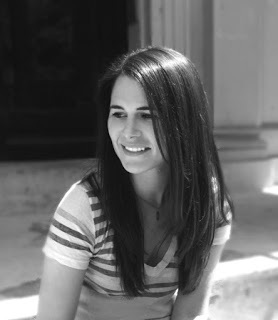 E. J. Mellow, Author
E. J. Mellow, AuthorTHE DREAMERWelcome E. J. Mellow who brings us her first book in her Dreamland Series, THE DREAMER, which she places in the new adult contemporary fantasy genre. Reviewers love the “unique” plot and claim her “world-building skills are breathtaking” and “character development was perfection!” She claims she has “always been fascinated with dreams.”
Mellow is close to finishing the second book in the series, which she plans to release this fall. A doodler, who reads and plays video games, she is a member of Romance Writers of America and their Fantasy, Futuristic and Paranormal Chapter. She currently lives in Brooklyn, New York.
E. J. Mellow: Before we jump into the Q&A, I just wanted to give a big hug of thanks to Joyce and Strands Simply Tips for having me here today. Really excited to dive into these questions!
Q: You describe the first book THE DREAMER of your Dreamland Series books as new adult contemporary fantasy. What are the characteristics of this genre? How is it different from other types of fantasy books? Who are the targeted readers?
E. J. Mellow: I mainly specified new adult to let people know that the Dreamland Series has some mature language and sexual content. It’s not explicit, but it does have the “nookie,” as I’m sure no one calls it.
The characteristics of NA contemporary fantasy, I think, are that it takes place in present day, has elements of magic or sci-fi, and is targeted for a slightly older audience than teens. Though my book’s age range is anywhere between 19 and 104. If you’re 105, sorry, it’s just not for you.
Q: How did you imagine THE DREAMER? What sparked (no pun intended, as I believe there was lightning involved) the plot?
E. J. Mellow: I’ve always been fascinated by dreams. The fact that we—on average—spend twenty-five years of our lives asleep is crazy. So the notion that we might, unknowingly, be living a completely other life during that time doesn’t seem that farfetched or out of the realm of possibility. For me, at least. ;)
But what really jump-started me writing THE DREAMER was actually a dream I had. One that lasted a whole week. Yes, a week! Each night it was like starting a movie right where I left off the night before, with the same characters and plot continuing. It was so insane! There also just so happened to be a guy…and yes, he was very good looking *hides behind hands*. Eventually these dreams stopped, but the idea of them stayed with me for a while. I ended up telling a friend about them, and from that conversation is where my idea for the series came about.
Q: One of your reviewers appreciates how “well developed and plausible” the book is. How important is “plausibility” to engaging your readers and telling your story?
E. J. Mellow: I think it’s important only to the effect that the readers shouldn’t be distracted from your story because they are wondering if the plot’s possible. That’s not why they are reading a fiction book. They are there to be entertained, swept away, and taken on a journey.
I also believe anything can be plausible if well written and told right. Warrior penguins that battle robotic mutant seals can be a conceivable story so long as the author can paint the world as such. Actually, Neil Gaiman gave great advice that relates to this. He said something to the effect of, treat the unreal things the same way you’d treat the real things. I think this is an awesome litmus test to writing a story with fantastical elements
Q: “I loved the characters, especially Molly and Dev—their relationship flew right off the page.” How did you create characters that involved your readers? How helpful was humor in developing your characters?
E. J. Mellow: It helps that my characters tend to feel no different to me than my friends in real life. I can easily imagine what they would be like accompanying me to certain social events. How Dev would charm the room and Molly would spill red wine on the sofa, covering it up with a pillow before anyone saw. Little quirks about them seem to always be swimming in my mind. But I believe the most helpful tip in building rich characters is to create profiles for them. List out their favorite foods, movies, books, pet peeves, and embarrassing moments. What they desire the most in their worlds and what they fear. I find this helps with staying true to who they are as a character. Also, give them a secret that no one but you and they will ever know.
As far as humor in developing characters, I think it’s definitely helpful, even if it’s subtle or small.
Q: How relevant was the concept of heroes vs villains to telling your story?
E. J. Mellow: Very, but not specifically heroes vs. villains, but rather positive thoughts versus negative and the outward effects they can have on a person.
Q: Many of your reviewers tout the page-turning momentum of the suspense you create. Can you tell us how you pulled your readers into the story?
E. J. Mellow: First, that’s super flattering to hear. So thank you to those reviewers! It’s something I set out hoping to achieve, and it’s nice to know some feel that I did.
I’m not 100 hundred percent certain there’s an exact method or by-the-book way to achieve good pacing, but something I learned in writing classes and reading other books is it helps when chapters end on a…kind of moment. You never want to sum up the chapter by solving all of its problems.
Q: Did you write THE DREAMER only to entertain readers, or did you want to deliver a message, create awareness, and/or educate?
E. J. Mellow: I never set out with the intentions of delivering one specific message with THE DREAMER, but I think the idea of dreaming big and not letting yourself fall into the cogs of life is a theme I wanted to get across. I think we all have greatness in us—we just need to wake it from sleep.
Q: How difficult was it to write a book from two different viewpoints? What did you do to minimize confusion?
E. J. Mellow: THE DREAMER is actually told only from Molly’s POV, but it does have aspects of two different viewpoints in the sense that her mind and attitude awake is very different then when she’s asleep. My writing style also switches slightly when Molly is in her dreams.
Q: What’s next?
E. J. Mellow: Currently, I’m finishing up the first draft of book two. And by finishing up, I mean there’s only a chapter left to write! I’m really excited about this one, for it’s a lot more action packed, and Molly and her powers get tested in ways no one is prepared for. There also were a lot of scenes that were tough for me to write, emotionally, which was an interesting challenge.
The second book is scheduled to come out late September/early October of this year, 2015. Hoping to have an official release date soon!
Q: Tell us about E. J. Mellow. What do you like to do when you’re not writing or dreaming?
E. J. Mellow: Playing video games, reading (lots of reading), and doodling in my sketchbook. I also live near a park and love to go for runs and hang with friends there.
About E. J. Mellow
E.J. Mellow is the author behind the NA Contemporary Fantasy trilogy The Dreamland Series. When she's not busy moonlighting in the realm of make-believe, she can be found doodling, buried in a book (usually this one), or playing video games.
Residing in Brooklyn, NY she is a member of Romance Writers of America and their Fantasy, Futuristic and Paranormal Chapter.
About THE DREAMER
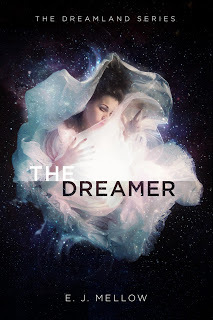 It’s night. Always night. Dreams guard against the evil forged by nightmares. Infinite shooting stars illuminate a moonless sky. A city stands alone, surrounded by a darkened field. On its fringes, a man watches one star separate from the masses and fall. What survives the crash will unveil a secret centuries long hidden.
It’s night. Always night. Dreams guard against the evil forged by nightmares. Infinite shooting stars illuminate a moonless sky. A city stands alone, surrounded by a darkened field. On its fringes, a man watches one star separate from the masses and fall. What survives the crash will unveil a secret centuries long hidden. Molly hasn’t slept well since the night of her twenty-fourth birthday. Being struck by lightning might have something to do with it, but then again, her chicken did look a little undercooked at dinner. Whatever the culprit, her life quickly catapults from mundane to insane as, night after night, Molly is transported through her once dreamless sleep to a mysterious land illuminated by shooting stars.
There she meets the captivating but frustrating Dev, and together they discover Molly possesses a power coveted by his people—the ability to conjure almost anything she desires into existence. Seduced by the possibilities of this gift, Molly shifts her attention from waking life toward the man, the magic, and the world found in her dreams.
But Molly must ask herself—does something truly exist if you only see it when you close your eyes?
Faced with the threat of losing everything—her job, best friend, boyfriend, and most importantly, that little thing called her sanity—Molly will learn just how far she’ll go to uncover what is real and what is merely a figment of her imagination.
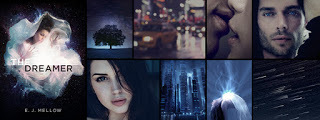
The first in a spellbinding contemporary fantasy trilogy, The Dreamer opens doors into the subconscious and follows the journey of a young woman torn between two worlds as she questions the power oSocial LinksWebsite Goodreads Instagram Twitter: www.twitter.com/ej_mellowFacebook
Published on June 25, 2015 19:23



